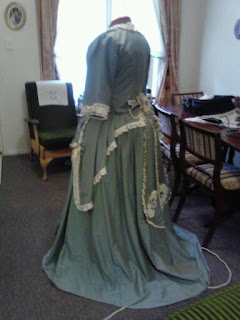

Please excuse my dummy I had to make it bigger and as you can see it is not quite right but it had to do or I would never get the costume finished.
I know I am late in getting it on my blog but I have been ill for almost three weeks the result of that is I will be three weeks late with every thing.
Challenge 4 Embelishment
Trim the costume started in 2008
I did not have a pattern for the bodice so I searched my library and the web to get some ideas of how I could trim it using only what I had in the house. I dont think there will be another costume like this but I did my best with what I had.
There are three parts to the costume
Bodice, Apron and Skirt
The lace I had was quite old (I dont know how old) it was the only one that I had plenty of and you need a lot for the 1870's .The lace was a tan colour which was no good for my costume so I decided to bleach it and see what colour it came out, to my relief it did not fall to pieces and it came out a nice creamy colour
which went very nice with the shot green.
Although I was running late I decided I would still hand sew the trim as I dont think the sewing machine does as nice a job
I tried various ways to trim which took some time as I sewed then unpicked about three times and finally ended up with using the lace double sewn together around the neck and sleeves then added braid to hide the seam in the centre where it was joined.
On the apron I used the trim single and put braid on the top side to hide my stitching
I decided to make a few bows and rosettes as both were popular in the 1870's
The skirt only has the hem tape and a six inch facing this has still to be done but as I wanted to start the next challege I decided to finish it another time.
As I had no pattern for the bodice I researched my library and the web to get some ideas on what to do
The bodice has nine hooks and nine thread loops
The eight buttons are hand made I do not know what you would call them except they are material circles which get a gathering stitch round to form a bowl and then stuff the edges into the bowl draw up the gathers and stitch the gap which then if you wish you can make a stem to either put through an eyelet or as I had done use them for decoration only.
The vertical trim down the bodice is there to hide the piece I had to put in as I had grown a bit since 2008.
The back of the bodice has a large bow with tails and a Rosette on the centre of the bow and the tips of the tails and the waist strap is in place.
The Apron has single trim with braid on one edge I made the bows and attached them on the side
The back with the Rosette's, I cant help feeling that they could be mistaken for the wings of a butterfly. I started making the rosette's with a gathered piece of the main material then added two rows of the lace then the braid went on to make a nice neat edge. The buttons are trimmed with a bit of tatting I had.and the edges of the tails are trimmed with some antique lace
The rosette on the bow is slightly different as I run out of the lace but I think it still looks okay
The Challenge: 4 Embelishment
Fabric: Silk and Cotton
Pattern: none
Year: 1873
Notions: Lace, and very old trim
How historically accurate is it? 90%
Hours to complete: hand sewing of trim 12 hours
First worn: never
Total co: unknown as I had all in the house bought many years ago

























































